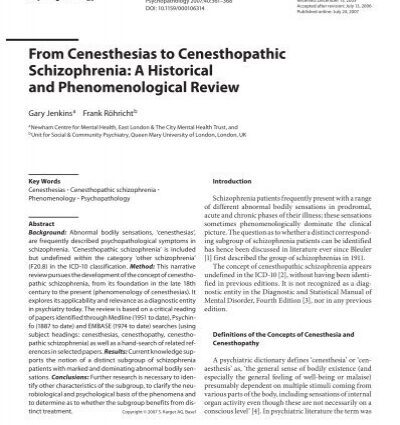Contents
Cenesthesia: definition of cenesthetic disorders
Cenesthesia, or internal sensitivity, designates the vague feeling that each individual has of all or part of his body, independently of the help of the sense organs. When this cenesthesia is disturbed, we speak of cenesthopathia or cenesthesia disorders which consist of a painful perception which cannot be explained by any anatomical lesion of the central nervous system and other organs. They are characterized by an abnormal sensation of the body with an unpleasant feeling of discomfort, discomfort, without real pain.
The management of cenesthopathia is based on the prescription of antidepressants and / or antipsychotics as well as non-pharmacological treatment options such as electro-convulsant therapy and psychotherapy.
What is cenesthesia?
Cenesthesia, or internal sensitivity, is the vague feeling that each individual has of all or part of their body, independently of the help of the sense organs.
Our sensory sensitivity is turned outward. It is exerted on the surface of our organism and brings us information provided by our five senses which are sight, hearing, smell, taste and touch. Qualified as objective, it depends on our cerebrospinal nervous system, that is to say on our brain, our marrow and the nerves which come from it.
In contrast, our extra-sensory, so-called internal and essentially subjective sensitivity gives us a way to know ourselves. It teaches us more or less profound changes that occur within our physical being as well as in the privacy of our moral being. It depends on our autonomic nervous system, that is to say on our sympathetic, its ganglia and its plexuses. Cenesthesia thus brings together our internal sensations which make us perceive ourselves as an organic whole, a living individual, a physical and moral “person”. It acts on our state of mood, our well-being or our discomfort, our joy or our sadness.
When this cenesthesia is disturbed, we speak of cenesthopathia or cenesthetic disorders, which consist of a sensation of pain, discomfort or discomfort without an organic cause, which is sometimes likened to a hallucination of deep sensitivity.
What are the causes of cenesthetic disorders?
On the psychopathological level, the origin of all cenesthetic disorders is a disorder of internal sensitivity, that is to say of the ability of the brain to be able to perceive or work out all the sensations coming from all the points of the body.
In the normal state, this internal sensitivity does not impose itself on our attention by any particular character. The pathological state is characterized by an awareness of this singular function or rather of the alteration of its normal functioning. It is only secondarily to these disorders of cenesthesia, that pathological phenomena of an emotional or motor nature will develop, giving the patient the appearance of an anxious, obsessed, hypochondriac or hypochondriac. a delusional.
What are the symptoms of cenesthetic disorders?
Disorders of cenesthesia affect the sense of personality. The patient believes himself transformed in his physical or moral being, often in both at the same time. For example, the patient may feel as light as a feather, feel taller than the room he is in, or even think he can float in the air. Other patients lose the sense of existence, declaring to be dead, immaterial or even immortal.
In the case of cenesthetic hallucinations, the patient has the impression of no longer being himself, that part or all of his body has dematerialized or that he is possessed by an external force that causes strange sensations. bodily, such as the presence of a stuck ridge at the back of the throat (which does not exist or no longer exists), or a thickened, impermeable part of the lung that is unfit for breathing. These sensations are generally unbearable, and more embarrassing and distressing than painful.
Internal zoopathy is one of the local cenesthetic disorders. In this case, the patient is convinced that his body is inhabited by an animal such as:
- a rat, spider or chafer in the brain;
- a viper, a snake, a lizard or a toad in the intestine.
There are also so-called external cenesthesia disorders. In this case, for example, the patient has the impression that everything, apart from him, is strange and threatening. He no longer perceives objects except through a veil, he no longer experiences their authentic contact, the usual reality as well as the reassuring familiarity.
How to treat cenesthetic disorders?
The management of cenesthopathia is based on the prescription:
- antidepressants such as amitriptyline, milnacipran, paroxetine and mianserin;
- antipsychotics such as haloperidol, pimozide, tiapride, sulpiride, risperidone, perospirone and aripiprazole;
- medicines like lithium carbonate (mood regulator) and donepezil.
Non-pharmacological treatment options such as electro-convulsant therapy and psychotherapy can complement the management.
Finally, homeopathic treatment with Sabadilla can reduce anxiety states and sensitivity disorders accompanying cenesthopathy.










